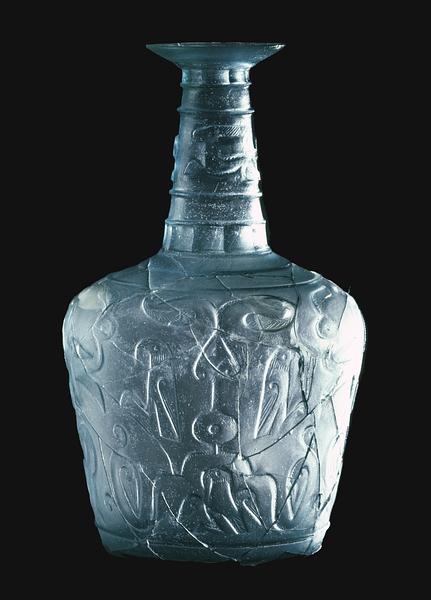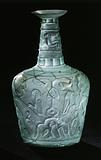Bottle, greenish glass, with relief-cut decoration
Iraq or Iran; 9th-10th century
H: 21.5 cm
This fairly large bottle features a relief decoration that was produced on a grinding wheel, leaving the glass only a few millimeters thick in some areas. The highly stylized birds and running, four-legged animals are often found in Abbasid art. The same is true of the vegetal ornamentation, which seems abstract. The circular shape with a central raised section, in contrast, is a motif that survived from the Sasanian period. A bottle with such complex and painstakingly executed decoration was made for a wealthy clientele. The same glassmakers created even more costly versions in rock crystal for society’s absolute elite.
Inv. no. 10/1963
Published in:
Journal of Glass Studies, 6, 1964, fig. 16, p. 159;
C .L. Davids Samling. Fjerde Del : Jubilæumsskrift 1945-70, København 1970, cat.no. 15, p. 134-135 og 140;
André Leth: Davids Samling. Islamisk kunst = The David Collection. Islamic Art, København 1975, p. 15;
Art from the World of Islam. 8th-18th century, Louisiana, Humlebæk 1987, cat.no. 18;
Kjeld von Folsach: Islamic art. The David Collection, Copenhagen 1990, cat.no. 221;
Kjeld von Folsach, Torben Lundbæk and Peder Mortensen (eds.): Sultan, Shah and Great Mughal: the history and culture of the Islamic world, The National Museum, Copenhagen 1996, cat.no. 141;
Jens Kröger: “Vom Flügelpaar zur Flügelpalmette Sasanidische Motive in der islamischen Kunst” in Barbara Finster, Christa Fragner, Herta Hafenrichter (eds.): Bamberger Symposium: Rezeption in der islamischen Kunst vom 26.6.-28.6.1992, Stuttgart 1999, pl. XXVII:5;
Stefano Carboni and David Whitehouse: Glass of the Sultans, Corning Museum of Glass, New York 2001, cat.no. 96;
Kjeld von Folsach: Art from the World of Islam in The David Collection, Copenhagen 2001, cat.no. 313;
Jacqueline du Pasquier: Histoire du verre: les chefs-d'oeuvre de l'islam, Paris 2007, p. 92;
Marcus Pilz: Transparente Schätze : Der abbasidische und fatimidische Bergkristallschnitt und seine Werke, Darmstadt 2021, p. 91, note 18 and p. 93, Abb. 46;


